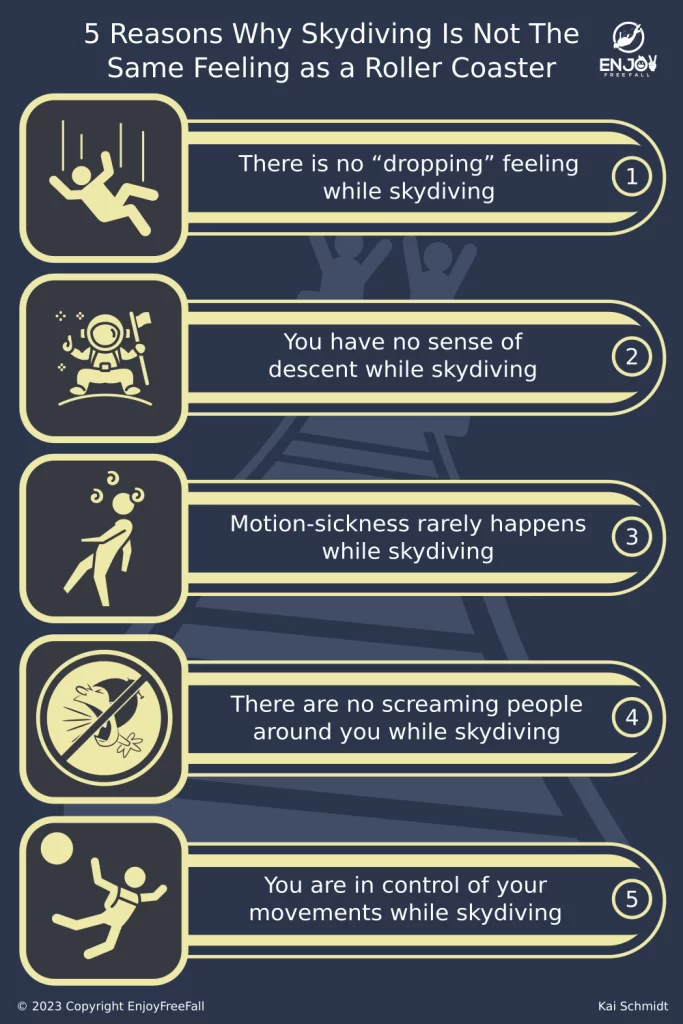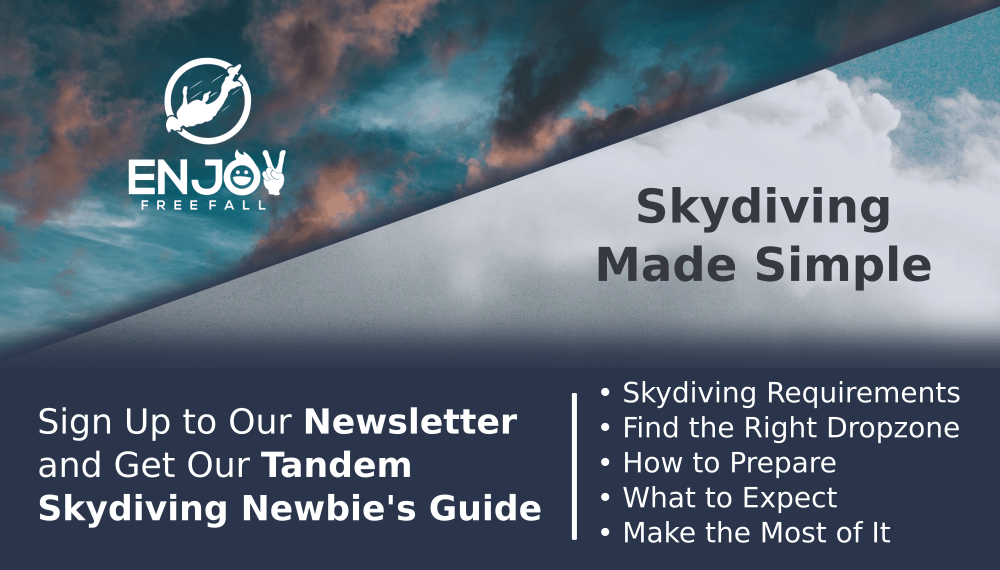
When skydiving for the first time, many people can’t help but compare the feeling of falling from a high altitude with the experience of riding a roller coaster. But does the rush of skydiving truly evoke the same feelings as that of a roller coaster ride?
Skydiving does not evoke the same feeling as riding a roller coaster because:
- You Don’t Experience a “Dropping” Feeling While Skydiving
- You Have a Lower Sense of Descent While Skydiving
- Motion-Sickness Rarely Happens While Skydiving
- There Are No Screaming People Around You
- You Are in Control of Your Movements
While both activities offer a unique experience, they are not the same and one may surprise you with its level of danger. Let’s explore the differences between the two and find out which one may be more suited for thrill-seekers.
5 Reasons Why Skydiving Is Not the Same Feeling As A Roller Coaster
When trying a new activity, it is normal for people to compare it to the most extreme activity that they have ever done, which for most people is a roller coaster ride.
Indeed, skydiving and riding a roller coaster are adrenaline-pumping activities and both begin from a high altitude, however, that’s where their similarities end.
If you’re seeking the same exhilarating rush as roller coasters and skydiving, there’s a myriad of adrenaline-pumping activities waiting for you. I’ve compiled a blog post featuring 13 activities you will enjoy if you like skydiving. Don’t miss out – explore the excitement right here!
There Is No “Dropping” Feeling While Skydiving
When a roller coaster climbs to the top of a hill or tower, it builds up potential energy that will be used to speed its descent, and then it converts that potential energy to kinetic energy that it uses to go up the next hill.
At the top of a hill, a roller coaster starts at 0 mph before diving down at full speed between 60-120 mph (depending on the height and inclination of the hill)
This sudden change and increase in speed can result in passengers feeling a lurch in the pit of their stomachs or a “drop” feeling.
Did you Know? The Formula Rossa in the UAE holds the record for the fastest speed of a roller coaster at 149 mph (240 km/h) since November 2010 – which is even faster than the typical skydiving terminal velocity of 120 mph!
In skydiving, there’s no “dropping” feeling since the aircraft – unlike a roller coaster at the beginning – is not stationary but is actually already moving at a forward speed of around 50-90 mph.
Most people do not realize it, but skydivers, unlike their roller coaster counterparts, do not start their freefall at 0 mph. As the skydivers exit the aircraft, they will already be moving.
As a result, the acceleration might be lower and therefore, skydivers do not experience the dropping feeling in their stomachs. While on a freefall, the air serves as a “cushion” for the skydivers and some even describe the feeling as simply “lying on their bed”.
It only takes skydivers a few seconds before reaching the terminal velocity of 120 mph. But did you know that skydivers can manipulate their terminal velocity?
You Have No Sense Of Descent While Skydiving
Roller coaster passengers have a strong sense of descent as they are attached to a “car or train” on the track with zero control over its movement.
Since roller coasters are only hundreds of feet in height, passengers can easily see how far they are from the ground by simply looking down. Roller coaster cars are often artificially accelerated on their downward trajectory to increase their speed.
Did you know? While the Kingda Ka in the US holds the record for the longest roller coaster drop at 418 ft (127 m). It is only a minuscule drop compared to that of the average skydiving attempt which happens between 10,000-15,000 ft (3,048-15,240 m) but still impressive!
During a freefall, skydivers float in the air for about 40-60 seconds until it’s time for them to deploy their parachutes. With the help of air resistance, skydivers won’t have a sense of descent and won’t exactly know how far they are from the ground.
That’s the reason why skydivers use a piece of equipment called an “altimeter” to monitor their distance from the ground and know the perfect time to open their parachutes.
The freefall is so smooth that there is a possibility of being too busy looking at the vast beauty of the horizon and enjoying the air rush to the face than focusing on opening the parachute.
If you’re on the lookout for spectacular scenery during your canopy ride, make sure you explore my article, uncovering the top 15 wingsuit destinations worldwide. While the article primarily spotlights wingsuit flying, these locations offer equally captivating opportunities for traditional skydiving!
Motion-Sickness Rarely Happens While Skydiving
It is normal for people to experience sensory overload and motion sickness while engaging in extreme activities. It is pretty common for roller coaster passengers to experience dizziness, fluttering, or nausea as they plummet down from the edge of a hill at a very high speed.
Aside from the hills, most roller coasters have several inversions (upside-down sequences) before flipping back to an upright position. These rapid movements can increase the chance of experiencing motion sickness while on a roller coaster.
If you’re up for a challenge then the Smiler in the UK currently has 14 inversions and holds the record for the greatest number of inversions for a roller coaster.
Motion sickness while skydiving is not common and rarely happens. During tandem jumps, the tandem student won’t feel sick as long as they do the following:
- eat a light snack before the jump (having an empty stomach or being full is not advisable),
- stay hydrated,
- and take an over-the-counter motion-sickness medicine if they have a previous history.
More experienced skydivers even do front flips or backflips without feeling dizzy or nauseous. As a skydiver’s experience progresses, he will learn to fully control his body during freefall which will make him more stable and ready to perform different skydiving maneuvers.
If you’re curious about more physical effects of skydiving, check out my post about the 11 incredible effects of skydiving on your body. You’ll learn all about how this thrilling activity can impact your physical and mental health in surprising ways.

There Are No Screaming People Around You While Skydiving
Even though a roller coaster ride normally lasts for only a couple of minutes, the entire ride is filled with passengers screaming with either fear or happiness or both.
During extreme activities, people experience a surge of energy and adrenaline, and screaming at top of their lungs helps them release this excess energy. It is a great way to calm nerves and feel more relaxed.
Screaming is also highly recommended when skydiving. The only difference is that in skydiving, as you will be at a terminal velocity of 120 mph, you will hear only the rushing sound of the wind instead of the screams of others.
Screaming out loud while skydiving will help you to breathe normally and feel more at ease during the entire freefall.
During tandem jumps, you won’t hear a sound from your instructor while freefalling and most of the communication will be by tapping your arms or shoulders. So, you can enjoy your own screams.
Once you are under the canopy, your speed will reduce from 120 mph to around 20 mph (almost an 80% reduction) and you can have small talks with your instructor.
You Are in Control Of Your Movements While Skydiving
When riding a roller coaster, you are fastened to the seat of the car and your movements will be restricted. In skydiving, however, skydivers can perform different maneuvers while on a freefall or riding under the canopy.
During tandem jumps, as you are attached to a trained instructor, you will be in a stable belly-to-earth position. Once under the canopy, the instructor will control the parachute and may allow you to do a simple left or right turn.
If you decide to add a picture and video package, you can wave, blow a kiss or even do silly poses in front of the videographer
If you want to learn more about the 5 reasons why skydiving videos are worth it, please check this post.
For solo skydivers having control over their movements makes up a huge part of the fun.
They can perform more difficult movements such as back flying, front or backflip, track, and even participate in formation jumps wherein they will recreate different shapes and forms while freefalling.
During canopy rides, skydivers can also do other movements like 360 degrees turns and flaring.
Is Skydiving Scarier Than Riding A Roller coaster?
Skydiving and roller coaster riding are both scary – especially if it is your first time! Personally, I would say that skydiving is less frightening than riding a roller coaster. Here’s why:
During a roller coaster, you will feel scared just by simply waiting in line and hearing the screaming people on the ride. The fear will continue to build up and will reach a peak when you take the ride with all its twists and turns and inversion. Your heart will continue pounding even after you reach a full stop.
When it comes to skydiving, it is also normal to be scared and feel nervous, especially inside the aircraft before your jump.
As soon as you exit the plane and begin freefalling, you will realize that there is nothing to be scared of as skydiving is so smooth. You will float in the air as you experience the closest that humans can get to flying.
During tandem jumps, you will be attached to a trained instructor who has made thousands of jumps and is experienced enough to resolve any potential malfunctions in a matter of seconds. These instructors will also give you tips on how you can overcome your nervousness e.g., by controlling your breath, keeping your chin up, and looking to the horizon.
When your parachute is deployed, you will have a peaceful canopy ride for about 5-6 minutes during which you can soak in the breathtaking and majestic view below you. Experiencing a bird’s eye view of the beautiful landscape, mountains, fields, rivers, and forests is not a scary but rather a once-in-a-lifetime experience.
Now you might say: “But I am afraid of heights, and the height is huge in skydiving.” Yes, you are right. However, there are very good reasons to skydive when being scared of heights.
Is Skydiving More Dangerous Than Riding A Roller coaster?
If you compare the fatalities, then skydiving is about 1.500 times more dangerous than riding a roller coaster. While thrills and danger come hand in hand, the safety of skydivers and passengers are the top priority of skydiving centers and amusement parks alike.
According to the International Association of Amusement Parks and Attractions (IAAPA), riding a roller coaster is extremely safe with only around one fatal incident per every 750 million rides. One of the major causes of death is having a pre-existing medical condition (some passengers that have lost consciousness while riding during or after the ride have later died).
In comparison, skydiving is still a small niche since there are only around 3 million jumps made each year. Tandem skydiving is considered around 2.5 times safer compared to solo skydiving with only one tandem student fatality for every 500,000 jumps and only one fatality for every 220,000 solo jumps.
The main reason why we still have fatalities in skydiving is human error. If you want to learn more about the true risks of skydiving, check out this post.
Over the years, skydiving is becoming increasingly safer with the continuous development of skydiving equipment and a strict following of the safety regulations set by the USPA and the FAA.
Enjoy your freefall!




